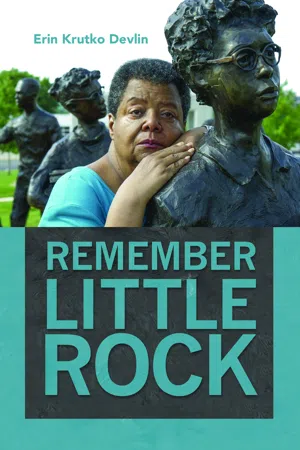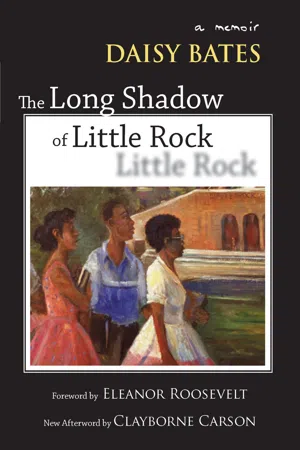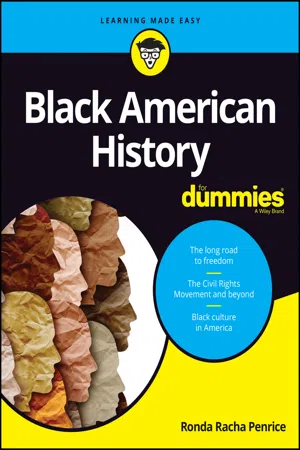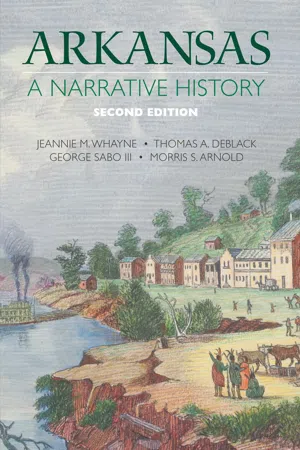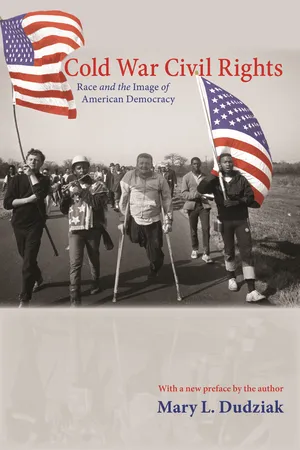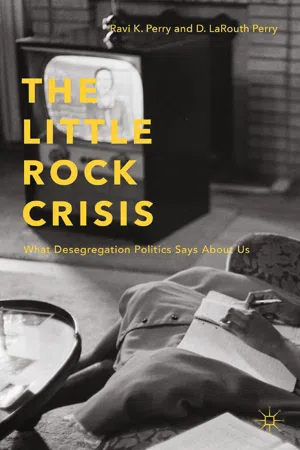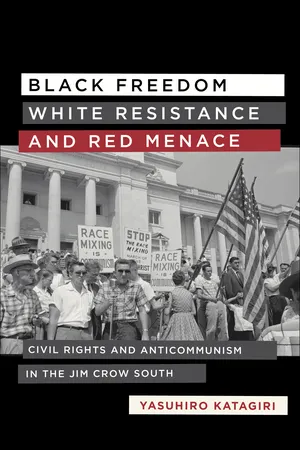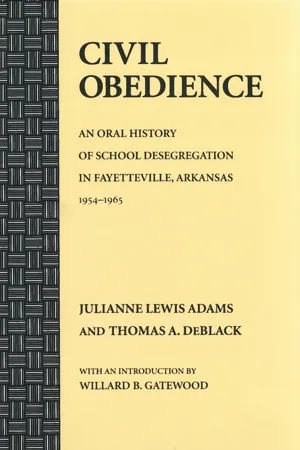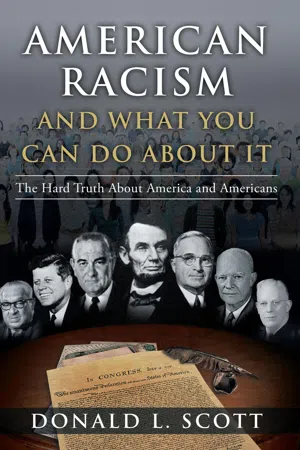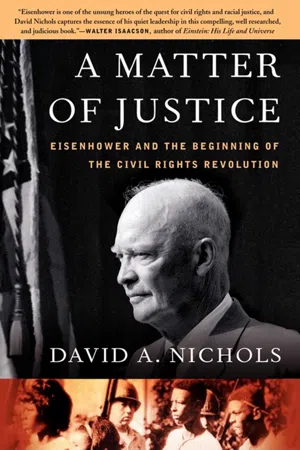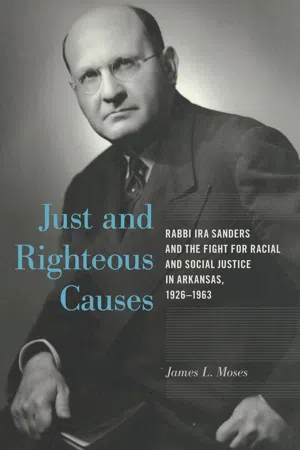History
Little Rock Nine
The Little Rock Nine refers to a group of African American students who were the first to integrate Little Rock Central High School in Arkansas in 1957. Their enrollment was met with violent opposition, leading to a significant moment in the civil rights movement. The event highlighted the struggle for desegregation and the bravery of those who fought for equal rights.
Written by Perlego with AI-assistance
Related key terms
12 Key excerpts on "Little Rock Nine"
- eBook - ePub
- Erin Krutko Devlin(Author)
- 2018(Publication Date)
- University of Massachusetts Press(Publisher)
5 In this spirit, the Little Rock Nine have challenged the way the Little Rock school desegregation crisis has been framed through memoirs, films, and countless speaking engagements. In doing so, they have resisted the processes of historical erasure that support “Won Cause” mythology and have worked toward preserving a “memory for the future” designed to build and sustain a more equitable society.FIGURE 11. The Little Rock Nine have engaged directly with the public memory of the 1957 school desegregation crisis, challenging Arkansas and the nation to confront its history. The power of their personal testimony is symbolically evoked in the Testament monument, in which bronze statues representing the Little Rock Nine stand on the lawn of the Arkansas State Capitol, visible from the same governor’s office once occupied by Orval Faubus. (Raymond K. Cunningham, Jr.)The contest over the public memory of the school desegregation crisis has deeper implications and broader social effects. The reification of the triumphal narrative of progress into Supreme Court jurisprudence at the turn of the twenty-first century demonstrates that our public histories matter. The logic undergirding the Court’s recent school desegregation decisions has been rooted in an effort to define racial discrimination as narrowly as possible, minimizing its effects in the past and its persistence in the present. In this context, contemporary racial inequality has not been attributed to systemic racism or institutionalized white privilege, but rather to “natural” preferences or cultural deficiencies within black communities. Moreover, the triumphal narrative of progress has enabled a “rearticulation” of the functional meaning - eBook - ePub
The Long Shadow of Little Rock
A Memoir
- Daisy Bates(Author)
- 2007(Publication Date)
- University of Arkansas Press(Publisher)
CHAPTER XI
THE EMBATTLED NINE
THE first few days at Central High School didn't add up to the most pleasant experience ever enjoyed by the nine Negro pupils, but neither was it the worst. In fact there were encouraging signs that the “Battle of Little Rock” was about to fade into history and that the process of integration might henceforth proceed without incident.Minnijean was invited to join the school glee club, others were invited to lunch with their white fellow-students. A few days before the embattled nine entered the high school, the student newspaper, the Tiger, carried the following article, written by Jane Emery, co-editor of the paper:You are being watched! Today the world is watching you, the students of Central High. They want to know what your reactions, behavior, and impulses will be concerning a matter now before us. After all, as we see it, it settles down now to a matter of interpretation of law and order.Will you be stubborn, obstinate, or refuse to listen to both sides of the question? Will your knowledge of science help you determine your action or will you let customs, superstition, or tradition determine the decision for you?This is the chance that the youth of America has been waiting for. Through an open mind, broad outlook, wise thinking, and a careful choice you can prove that America's youth has not ‘gone to the dogs,’ that their moral, spiritual, and educational standards are not being lowered. This is the opportunity for you as citizens of Arkansas and students of Little Rock Central High to show the world that Arkansas is a progressive, thriving state of wide-awake alert people. It is a state which is rapidly growing and improving its social, health, and educational facilities. That it is a state with friendly, happy, and conscientious citizens who love and cherish their freedom.It has been said that life is just a chain of problems. If this is true, then this experience in making up your own mind and determining right from wrong will be of great value to you in life. - eBook - ePub
- Ronda Racha Penrice(Author)
- 2021(Publication Date)
- For Dummies(Publisher)
A mob of roughly 300 gathered by morning. When the nine Black students, called the Little Rock Nine, tried to enroll in Central High the next day, members of the Arkansas National Guard turned them away. Frantic, the school board requested a stay of the integration order on September 7, but Judge Davies rejected the request. On September 10, Governor Faubus received a federal summons; he also held a press conference and announced that the armed presence outside the school would remain. Wisely, the Little Rock Nine didn’t attempt to enroll again before the hearings. On September 20, Faubus, following a court order, removed the troops. Eisenhower steps in and the students enroll On September 23, the Little Rock Nine made another attempt to enroll in Central High, but uncontrolled violence erupted and they left school before the day ended, spurring President Dwight D. Eisenhower to intervene. Although far from a drum major for integration, Eisenhower wouldn’t permit blatant disregard for the laws of the land. On September 24, President Eisenhower addressed the American public on national television to explain his decision to intervene. He said, “The very basis of our individual rights and freedoms rests upon the certainty that the president and the executive branch of government will support and insure the carrying out of the decisions of the federal courts.” He insisted, “The interest of the nation in the proper fulfillment of the law’s requirements cannot yield to opposition and demonstrations by some few persons. Mob rule cannot be allowed to override the decisions of our courts.” Protected by federal troops, the Little Rock Nine enrolled in Central High on September 25, 1957, but they continued to be victimized. White students verbally and physically abused them, and segregationists harassed their families and members of the Black community in general. Bowing to the pressure, Minnijean Brown poured a bowl of chili over a white student’s head and was expelled - eBook - ePub
Arkansas
A Narrative History
- Jeannie M. Whayne, Thomas A. DeBlack, George Sabo, Morris S. Arnold(Authors)
- 2014(Publication Date)
- University of Arkansas Press(Publisher)
Aaron v. Cooper (Aaron the name of the first child listed on the suit; Cooper being William G. Cooper, president of the Little Rock School Board). Their efforts and their suit were undermined by the actions of Little Rock’s white school superintendent Virgil Blossom and the Little Rock School Board, which presented an integration plan that was far different from what the black activists promoted. It provided for only modest integration of Central High School, a school in a working-class neighborhood. Yet Daisy Bates and a small group of African American activists decided to work with Blossom, and they carefully selected nine students—who became known as the “Little Rock Nine”—to make the move into Central High School in the fall of 1957: Minnijean Brown, Elizabeth Eckford, Ernest Green, Thelma Mothershed, Melba Pattillo, Gloria Ray, Terrance Roberts, Jefferson Thomas, and Carlotta Walls.”Aaron v. Cooper: A suit filed by the parents of thirty-three black students in Little Rock after the Supreme Court issued its “all deliberate speed” decision in 1955, a follow-up to the Brown decision in 1954.Little Rock Nine: The nine black students who integrated Central High School in Little Rock in 1957.Even as Bates was preparing the children for entry into Central High, Faubus took another step away from racial progressivism and mortgaged his political future to the extreme segregationists in order to secure approval of an ambitious twenty-two-million-dollar legislative package. To gain the support of east Arkansas planters for a package that included increases in benefits to the elderly and higher teacher salaries, Faubus acquiesced to four bills designed to delay desegregation, something that was not so very far from measures he hinted might be necessary in his first run for the governor’s office in the race against Cherry. These measures, if Faubus had attempted to enforce them, would have provided financial aid to schools attempting to resist integration, changed school attendance laws in a manner designed to make sure that certain whites did not have to attend school with blacks, required the NAACP to publish its membership lists, and established a state sovereignty commission with the express purpose of studying how to effectively block federal integration efforts. When Faubus failed to enforce the four measures, pressure from the extreme segregationists mounted. - eBook - ePub
Public Opinion in the United States
Studies of Race, Religion, Gender, and Issues That Matter
- Rita J. Simon(Author)
- 2017(Publication Date)
- Routledge(Publisher)
Board of Education, the National Association for the Advancement of Colored People (NAACP) registered nine black students, later known as the Little Rock Nine, to attend the previously all-white Little Rock Central High School. But segregationists threatened mass protests, and the State Governor deployed the Arkansas National Guard on September 9, 1957, to block the nine black students from reaching their school. The incident attracted national attention, and raised the polarizations between the two groups supporting and opposing racial integration. President Eisenhower intervened and summoned the Arkansas governor to meet him.Attorneys from the U.S. Justice Department requested an injunction against the governor, which was granted, and the District Court for the Eastern District of Arkansas ordered the governor to withdraw the National Guard on September 20. The police then slipped the students into their schools, and confronted the protesting parents of white students. On September 24, President Eisenhower ordered the deployment of army troops in Little Rock, and federalized the Arkansas National Guard to ensure the safety of the Little Rock Nine and enforce integration.Another event that helped spread the Civil Rights cause was the so-called Greensboro sit-ins in 1960. Sit-ins were an established technique for the Civil Rights Movement given its overall nonviolent approach to social change. However, these sit-ins were the most influential because of the media attention they attracted and their broad scope. The events leading to the protest started in February 1960, when four students from North Carolina Agricultural and Technical State University (NC A&T), a historically segregated school, were denied the right to sit down in the Woolworth lunch counter. They were told that because of their race they had to stand up at another counter to eat. The young men stood and stayed until the store closed, and students returned to sit-in the next day. This protest continued for six months, joined by other similar protests in different cities and states. While many local stores changed their policies regarding racial segregation, the main legal change had to await the passage of the landmark Civil Rights Act of 1964, which was followed by the Voting Rights Act of 1965.1 - eBook - ePub
Politics and Society in Modern America
Race and the Image of American Democracy
- Mary L. Dudziak(Author)
- 2011(Publication Date)
- Princeton University Press(Publisher)
CHAPTER 4
Holding the Line in Little Rock
Little Rock has unfortunately become a symbol of Negro-White relations in the United States.AMERICAN CONSULATE, LOURENÇO MARQUESZ, MOZAMBIQUETO DEPARTMENT OF STATE, SEPTEMBER 30, 19571The school year would not begin easily in Little Rock, Arkansas, in 1957. On September 4 of that year, nine African American students tried to enroll at Little Rock’s Central High School. Their admission had been ordered by a federal district court. However, just two days earlier, Arkansas Governor Orval Faubus declared that the students’ enrollment threatened “imminent danger of tumult, riot and breach of the peace and the doing of violence to persons and property.” He proclaimed a state of emergency and ordered the Arkansas National Guard into service. These troops surrounded Central High School on September 4 and turned the students away as they tried to enter the school.2What transpired that day would capture the attention of the international media and of President Dwight D. Eisenhower. School desegregation in Little Rock was no longer a local or state issue, but a critical national problem.3As the Arkansas Gazette reported it,The first Negro applicant to try to enroll at Little Rock Central High School . . . , Elizabeth Eckford, 15, was twice blocked from entering the grounds, walked calmly down two blocks then sat out 35 minutes of vocal abuse while waiting for a bus to go home. . . . When she approached Guardsmen at the corner they drew together and blocked her entrance to the sidewalk.4Eckford was harassed in front of television cameras as “a crowd of 200 saw her and rushed to the scene.” A white woman, Grace Lorch, ultimately came to her defense and boarded a bus with Eckford, taking her away from the scene. Seven of the nine students arrived together and, on orders of the governor, were also turned away.5Governor Faubus was something of a latecomer to resistance. Little Rock had a reputation as a progressive southern community, and Faubus had been thought of as a moderate. In contrast to Georgia Governor Herman Talmadge, Faubus had given no speeches of defiance after Brown was decided. Instead, he gave African Americans a role in the state Democratic leadership during the 1954 gubernatorial campaign. In addition, there was progress, albeit with mixed success, toward desegregation in other communities in Arkansas after 1954. Faubus’s most direct statements on school desegregation prior to Little Rock were to declare the issue a local one, to be handled by local school boards.6 - eBook - ePub
The Little Rock Crisis
What Desegregation Politics Says About Us
- R. Perry(Author)
- 2015(Publication Date)
- Palgrave Macmillan(Publisher)
That Act also gave additional powers to the office of the US Attorney General, who could now seek court injunctions against deprivation and obstruction of voting rights by state officials. 15 Cultural histories collided in Little Rock in 1957 without regard to national or neighboring histories. It must be that Little Rock was destined to make its unique, permanent, and, eventually, regrettable mark on history by denying nine African American students entrance into the all-white Central High School. * * * A theme of this book is to examine how acquired cultural habits determine present behavior and how exposure to the crisis has impacted people’s political behavior. The desegregation crisis dramatized for the world how problematic it is for conflicting belief systems to coexist. The probe into what happens when cultural histories meet will perhaps explain why the memory of the crisis won’t fade for many, and why the learning of the crisis has changed the lives of many who weren’t even alive when it occurred. This book offers several contributions. We have taken on the task of telling, while analyzing some of the first key texts on the crisis, the story of Little Rock’s desegregation crisis and how that story has lived itself over time, in the lives of many. The invaluable sources we’ve used focus on the crisis through the lens of the moment—a single component of the crisis; for example, Crisis at Central High concentrates on the 1957–1958 school year events within the school. 16 The Long Shadow of Little Rock reveals Daisy Bates’s involvement with the community, the school board, and the Little Rock Nine during the same year. 17 Books by Superintendent Blossom, Dale Alford, Sara Murphy, Terrence Roberts, Carlotta Walls LaNier, and Melba Pattillo Beals present details of their participation - eBook - ePub
Black Freedom, White Resistance, and Red Menace
Civil Rights and Anticommunism in the Jim Crow South
- Yasuhiro Katagiri(Author)
- 2014(Publication Date)
- LSU Press(Publisher)
CHAPTER 4
“A PEACEFUL PEOPLE HAVE BEEN TORN ASUNDER BY THE COMMUNIST CONSPIRACY”The Little Rock Desegregation Crisis in Arkansas as aTurning Point in Massive Resistance
In several respects, the 1957 Little Rock, Arkansas, desegregation crisis was one of the defining moments in America’s civil rights movement. With the values of American democracy at stake in a Cold War environment, federal troops, for the first time since Reconstruction, used their might to protect black civil rights in the South, demonstrating the federal government’s resolve to bolster the “American way of life” in the face of southern defiance. Not only was the Little Rock crisis the first dramatic confrontation between a southern state and the federal government over school desegregation, but it also represented a pivotal turning point in white southerners’ resistance movement to the civil rights crusade. After the Little Rock incident, the architects and practitioners of the South’s massive resistance realized that their strategy of employing the revived theory of states’ rights constitutionalism—or the doctrine of interposition—could no longer be counted upon to preserve the region’s racial segregation.One of the central figures in the Little Rock desegregation ordeal, who eventually ended up siding with the proponents of massive resistance, was Arkansas governor Orval E. Faubus. Elected as governor of the Peripheral South state six months after the Supreme Court announced its May 1954 Brown decision, Faubus had never been a fanatic segregationist prior to the showdown at Central High School, where the capital city’s token desegregation process, devised by the Little Rock School Board, was to start in the fall of 1957 “with all deliberate speed.” In fact, Faubus, the son of a known Socialist, John Samuel “Sam” Faubus, and a racial moderate in the South’s contemporary standard, was an unlikely villain in the drama that unfolded over the desegregation of the city’s all-white Central High School.1 By the same token, the city of Little Rock was also an unlikely place for an all-out state-federal confrontation over public school desegregation. Though it may not have been a genuinely progressive southern city, Little Rock nevertheless showed a much greater degree of racial tolerance than did many cities in the Deep South states. Little Rock’s relative racial moderation, for instance, was evidenced in April 1956 in its voluntary abolition of segregated seating on the city’s public bus transportation system.2 - eBook - ePub
Civil Obedience
An Oral History of School Desegregation in Fayetteville, Arkansas, 1954–1965
- Julianne Lewis Adams, Thomas A. DeBlack(Authors)
- 1994(Publication Date)
- University of Arkansas Press(Publisher)
34Most of Fayetteville’s community leaders voiced opposition to the actions of Faubus and the legislature in 1957 and 1958. For many, the Little Rock imbroglio, publicized nationally and internationally in both words and photographs, was a source of profound embarrassment, even shame. In their view, it nullified efforts to overcome the image of Arkansas as a place inhabited by ignorant people and Gothic politicians. Little Rock in 1957–58 appeared to confirm for outsiders the validity of H. L. Mencken’s outrageous description of the state a generation earlier.35 A Fayetteville couple touring Europe late in the 1950s encountered so many inquiries from those appalled by what they read about Little Rock that when questioned about their place of residence in the United States they responded by saying they lived “near Texas.”36The Northwest Arkansas Times characterized the confrontation in Little Rock over the desegregation of Central High School as serving “no good purpose.” It was “not our way” of resolving problems. The Times was certain that the whole episode would “depress the atmosphere built carefully over a long period to attract industry” to the state. Others in Fayetteville, notably clergymen, were even less circumspect in denouncing Governor Faubus.37 “In other states . . .,” Walter L. Johnson of University Baptist Church declared, “the governors have called out troops to maintain the highest law in the land concerning integration of the races: in Arkansas a new thing has occurred, for Governor Orval Faubus who swore to uphold the laws of the nation has called out troops to keep the highest law of the land from being obeyed.”38 Scarcely less pointed was the reference to the Arkansas governor by E. E. Thwaites of the First Presbyterian Church as a man who possessed “no respect for the laws of the nation or more important the law of God.”39 Governor Faubus singled out Presbyterian ministers for special rebuke, claiming that they had been “effectively brainwashed” by “Communists and left-wingers.”40 - Available until 15 Sep |Learn more
American Racism and What You Can Do About It
The Hard Truth About America and Americans
- Donald L Scott(Author)
- 2020(Publication Date)
- Stratton Press(Publisher)
On September 3, 1957, school opening day at Central High, Faubus called up the Arkansas National Guard to ostensibly guard against unruly armed protesters, but his unpublicized direct order was to deny entry to the black students. The school board learned of Faubus’s action the morning of the school opening and called the parents of the nine black students to keep the student’s home. The television cameras and a large crowd occupied the headlines across the nation. The mayor of Little Rock denounced Faubus’s manufactured fears, and the school board requested instructions from the district court judge. The judge would not delay the plan. The ball was now in Eisenhower’s court.Eisenhower held a press conference and was asked about the school situation in Little Rock. He weakly supported Brown but did not believe federal force was appropriate and stated that the Justice Department was sending the FBI to assess the threat of armed protesters. He reiterated the futility of anyone who believed that laws could change the hearts and minds of people. He further elaborated that “there are very strong emotions on the other side, people that see a picture of mongrelization of the race, they call it.” His attorney general, Brownell, urged Eisenhower to enforce Brown II as he saw Little Rock as a test case for the southern states. All sides were locked into their positions; Faubus was committed to keeping the peace under his state constitution, the district court and schoolboard was standing behind it’s school integration plan, and Eisenhower did not want to use federal force.September 4, 1957, brought out the best and worse in the struggle to integrate Central High School. Two hundred plus National Guard troops surround the high school. The school board with the assistance of Daisy Bates, NAACP, the Little Rock School Board, and mayor of Little Rock arrange for the Little Rock Nine to attend their first day of school at Central High. Bates used her home as the meeting place for the students and arranged for the nine to be escorted to the school by eight ministers (four black and four white) with a city police car to move slowly with them. As the student and escorts neared the school, a crowd of four hundred jeering whites begin hurling racial slurs. “Go home niggers!” they yelled. “Two, four, six, eight, we ain’t gonna integrate,” they chanted. When the students arrived at the entrance, a National Guard Captain armed with a rifle and bayonet announced that by order of Governor Faubus, the students would not be allowed to enter the school. Once the crowd realized the National Guard was there to deny students entry, they became more embolden in their jeers and chants. One of the students, fifteen-year-old Elizabeth Eckford, did not get the message to meet at Bates’s house and began walking toward the school. She saw the crowd and the troops and assumed the troops were there for her protection. As she approached, the crowd hurled epithets at her and two National Guard Soldiers blocked her path with crossed bayonets. The crowd yelled, “Lynch her!” The fifteen-year-old five feet tall Elizabeth became terrified and retreated to a bench at a bus stop about one hundred yards away. She was visibly shaken when she was seated on the bench at the bus stop. An elderly white woman set beside her and put her arms around her until the bus carried them away from the harrowing scene. Faubus was now openly defying the order to integrate Central High School. - eBook - ePub
A Matter of Justice
Eisenhower and the Beginning of the Civil Rights Revolution
- David A. Nichols(Author)
- 2007(Publication Date)
- Simon & Schuster(Publisher)
CHAPTER EIGHTThe Little Rock Crisis
The Federal Constitution will be upheld by me by every legal means at my command. —DWIGHT D. EISENHOWER, SEPTEMBER 5, 1957O n Monday, September 2, 1957, in a 10:30 P.M. radio speech, Democratic Governor Orval Faubus of Arkansas announced that he had ordered units of his state’s National Guard to surround Central High School in Little Rock, preparatory to classes beginning the morning of September 3. Faubus claimed that he was sending the troops to prevent violence, but his real purpose was to prevent nine African-American children from entering the school in fulfillment of a federal court desegregation order.1This news was not welcome at the White House. Eisenhower was weary from the struggle to pass the civil rights act. The president needed a vacation, as did Mrs. Eisenhower, who was recovering from surgery, and they were scheduled to depart on Wednesday, September 4, “for a rest” at the Newport, Rhode Island, naval base. “Rest” to Eisenhower meant golf. He liked the course at the Newport Country Club and looked forward, according to Sherman Adams, “to entertaining a few friends whom he could beat when his game was right.”2 Thanks to Governor Faubus, Ike’s stay in Newport would not be much of a vacation.A Defiant GovernorA crisis in Little Rock had been simmering for some time. The city’s school board had adopted a plan on May 24, 1955, for gradual integration of the schools. The plan had called for implementation in fall 1957 and then only in the city’s high schools. Negro students were not eligible to enroll in the city’s high schools until 1957 but, in January 1956, twenty-seven African-American students attempted to register ahead of schedule and were turned away. On February 8 of that year, the NAACP filed suit on behalf of those students but Arkansas’ western district federal judge, John E. Miller, dismissed the suit. The Arkansas legislature passed bills on February 19, 1957, that abolished mandatory attendance at integrated schools and authorized funds for the state to use to fight integration. Governor Faubus, armed with these laws, tried to convince the Little Rock school board to rescind its integration plan, but the board refused. On April 27, 1957, the Eighth Circuit Court of Appeals upheld Judge Miller’s ruling against the NAACP’s suit and approved the school board’s original plan to implement limited integration in September 1957.3 - eBook - ePub
Just and Righteous Causes
Rabbi Ira Sanders and the Fight for Racial and Social Justice in Arkansas, 1926-1963
- James L. Moses(Author)
- 2018(Publication Date)
- University of Arkansas Press(Publisher)
On the issue of civil rights, Little Rock had since World War II enjoyed a reputation as a moderate city unlike Birmingham or Montgomery. It boasted a moderate mayor in Woodrow W. Mann, who, while not a personal advocate of classroom integration, was nonetheless fully prepared to implement the Supreme Court’s orders and the school board’s plans, and it was he who would request that Eisenhower send in troops to keep order. 18 Additionally, Little Rock had a progressive newspaper in the Arkansas Gazette under the editorship of Harry Ashmore, a moderate Democrat, Brooks Hays, in Washington as its representative, and a governor, Orval Faubus, who was not known for race-baiting, at least not yet. Indeed, in his January 1955 inaugural address, Faubus did not even mention segregation. Arkansas also had been the first former Confederate state to comply with the court’s 1954 Brown decision, when public schools in Arkansas towns such as Fayetteville, Charleston, and Hoxie integrated, if only in small numbers. By 1957, writes Ben Johnson, “about 940 African American students out of a total black student population of 102,000 were attending integrated public schools in Arkansas.” 19 The state and its capital city even before 1954 had already made many advances toward racial integration without major incident, as proudly related by the Little Rock Council on Education in its 1952 report. The University of Arkansas had, without court mandate or compulsion, opened its doors to racial integration in 1948, and other campuses around the state were in the process of following suit; by 1957, black students attended all seven predominantly white state colleges. The Little Rock Public Library, with Ira Sanders and Adolphine Terry as driving forces, already had quietly desegregated
Index pages curate the most relevant extracts from our library of academic textbooks. They’ve been created using an in-house natural language model (NLM), each adding context and meaning to key research topics.
